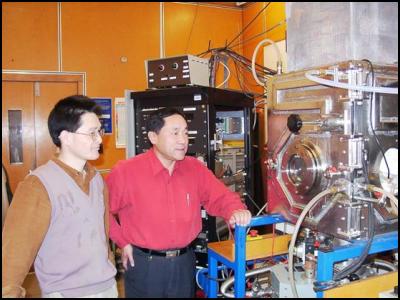New material to revolutionise opto-electronics
For immediate release
15 June, 2005
With photo
New material poised to revolutionise opto-electronics

Professor Gao (right) and Dr Li depositing zinc oxide onto glass substrates.
Researchers at The University of Auckland have successfully taken the first step towards developing a new generation of opto-electronic materials for use in devices such as screen display, solar cells and lasers which display information using electrical signals and light emission.
Professor Wei Gao and his group, in the Faculty of Engineering’s Department of Chemical and Materials Engineering, has developed a technique to make a very fine film of zinc oxide on substrates of glass, silicon and metal, which acts as a conductor or semi-conductor and emits light.
“Zinc oxide is very strange stuff. It’s cheap and is used as powder filler in oil and water-based white paint,”says Professor Gao.
“But what makes it really unusual is that you can run an electrical current through it, and it can be transparent with special light-emitting properties. These properties don’t usually occur together, for instance, metals are conducting but not transparent, while glass is transparent but not conducting. This makes it suitable for use in many kinds of electronic devices.”
Professor Gao, who started to research the properties of zinc oxide about five years ago, says his team has developed a n-type (negative) conducting zinc oxide with excellent photoluminescence, which gives very sharp UV radiation or red or green colour light, when it is “excited” with a laser signal.
But further work is needed to better control the properties of the n-type zinc oxide and to get stable light emission. The recent award of a Marsden grant, will take the project to the next stage, developing a p-type (positive) conducting zinc oxide which, says Professor Gao, is a much bigger challenge.
“We have good light emission using laser to excite the n-type zinc oxide. This is alright in the laboratory, but for application in electronic devices, we need to use an electrical signal. To do that we need to create a p-n junction, which will enable us to apply an electrical signal to get the light we want.”
If successful, Professor Gao says zinc oxide will become the base material for the next generation of opto-electronic devices, revolutionising the industry in the way silicon – now used everywhere in the world for silicon chips - revolutionised information and communications technology.
Zinc oxide, he says, will be cheaper than existing opto-electronic materials and has the potential to make visual display surfaces brighter and the colour easier to control.
But, he says, the research is complex as it is not yet well-understood why it is difficult to form p-type zinc oxide using traditional methods. A senior researcher in Professor Gao’s group, Dr Zhengwei Li, is using a special technique to make p-type zinc oxide – oxidation of zinc thin films at an extremely low oxygen partial pressure.
Together, with Dr John Kennedy at the Institute of Geological and Nuclear Sciences and Dr Roger Reeves at the University of Canterbury, Professor Gao says, the team will be applying innovative technology, developed within the Faculty of Engineering, to address the problem.
-ENDS-


 John Mazenier: Gaffer Tape And Glue Delivering New Zealand’s Mission Critical Services
John Mazenier: Gaffer Tape And Glue Delivering New Zealand’s Mission Critical Services Earthquake Commission: Ivan Skinner Award Winner Inspired By Real-life Earthquake Experience
Earthquake Commission: Ivan Skinner Award Winner Inspired By Real-life Earthquake Experience Reserve Bank: Consultation Opens On A Digital Currency For New Zealand
Reserve Bank: Consultation Opens On A Digital Currency For New Zealand NIWA: Ship Anchors May Cause Extensive And Long-lasting Damage To The Seafloor, According To New Research
NIWA: Ship Anchors May Cause Extensive And Long-lasting Damage To The Seafloor, According To New Research New Zealand Customs Service: A Step Forward For Simpler Trade Between New Zealand And Singapore
New Zealand Customs Service: A Step Forward For Simpler Trade Between New Zealand And Singapore Horizon Research: 68% Say Make Banks Offer Fraud Protection
Horizon Research: 68% Say Make Banks Offer Fraud Protection



